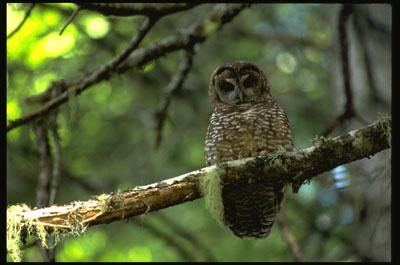EPA Science Matters Newsletter: EPA "Recovery Champions" Help Effort to Save Threatened Owl (Published January 2014)
EPA's HexSim computer modeling team works with U.S. Fish and Wildlife Service to save the northern spotted owl.

Ever since the northern spotted owl was labeled “threatened” under the Endangered Species Act in 1990, researchers have exhaustively studied just about every imaginable aspect of the bird, including its behavior, foraging patterns, and range. Though the owl itself is quite rare, information about the owl is plentiful. In fact, it must be one of the most-studied birds in the world.
In spite of all we know about the species, however, the spotted owl population continues to decline by about 3% every year.
The looming unanswered question about spotted owls is this one: how can we leverage our knowledge and understanding of the species into an effective plan for its recovery?
An EPA computer modeling team recently tried to answer that question by simulating spotted owl population dynamics, using a program they developed called HexSim. HexSim incorporates vast amounts of available data about dwindling wildlife species, such as spotted owls, to create scenarios involving virtual populations. The outcomes of the spotted owl simulations offered land managers valuable insight into how best to bolster the species’ declining numbers.
Replicating an ecosystem
Spotted owls live only in the Pacific Northwest, and only in mature old-growth forests, where the birds find the large, dead, standing trees they use for roosting and a closed canopy with enough room between trees to navigate and hunt. Spotted owls depend on very specific prey—red-backed voles and flying squirrels—that can be found only in this very specialized forest community. As this habitat is logged and destroyed, the spotted owl population dwindles.
In addition to continued shrinking habitat, spotted owls face another threat: competition from the barred owl, a larger and much more abundant species. Barred owls displace spotted owls, disrupt their nesting, and compete with them for food.
Drafting the most recent recovery strategy for the spotted owl began with a review of what habitat was still available, taking quality and ownership into account. The U.S. Fish and Wildlife Service scientists working on the plan had to strategize how the burden of conservation would be shared between public and private lands. But the stakes were high, and the owls few, so there was little room for trial and error. The planners wanted to know with as much assurance as possible what kind of strategy would offer the best chance for recovery.
To help formulate their plan, they called on EPA scientist Nathan Schumaker, Ph.D., who has been leading the development of HexSim. HexSim is capable of modeling a wide array of environments and projecting how organisms might behave and persist—or not—in those settings.
To study the needs of the spotted owl, Schumaker’s team replicated its entire habitat from Washington to California in HexSim. Then they populated the virtual habitat with virtual birds.
The virtual owls have the same basic needs as real owls; each one defends a territory and forages within a large home range. In areas of high-quality habitat, the virtual owls compete with each other for resources. Survival rates depend, in part, on resource availability, which vary from place to place and depend on latitude, logging history, and other factors. Where a spotted owl encounters a barred owl, its own chance of survival decreases.
The modeling team ran the simulated life cycle thousands of times under assorted conditions to test the effectiveness of different habitat reserve strategies. Managers were able to choose the strategy that offered the owls the most resources and the best chances to reproduce.
It was the first time that such modeling tools had been used to designate critical habitat. In recognition of what the U.S Fish and Wildlife Service called “successful and groundbreaking work,” the members of the modeling team were named “Recovery Champions,” an honor awarded to those whose work helps advance the recovery of endangered and threatened species of plants and animals.
Preventing future threats

According to Schumaker, new users can learn to design and run HexSim simulations in a matter of days. "HexSim simulations range from simple and abstract to complex and realistic,” says Schumaker. “Novice HexSim users will find they are able to construct simple models very rapidly. As the need for realism increases, more time must be devoted to model development and testing."
Because each simulation is user defined, there are unlimited ways that HexSim can be applied. The model currently is being used at EPA to quantify the effects of pesticide applications on the viability of kit foxes. Studies on black-footed ferrets (one of the most endangered mammals in the world), amphibians, and other species will follow in the near future.
Related Resources
- HexSim - model, user’s guide, and a sample workspace may be downloaded and used for free.
- Northern Spotted Owl Information (USFWS)
- Recovery Champions
